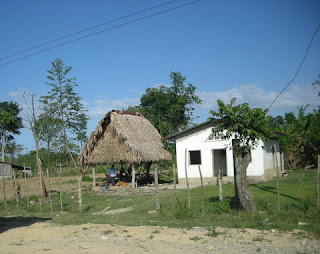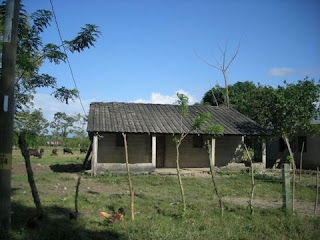 Part of our plan for the visit to Tripoli, Honduras, was to find a village elder, hoping they would know where the name Tripoli came from. El Jefe said the old folks are always the best ones to talk to about such things. See La Gringa goes to Tripoli for more about Tripoli, Honduras. (Click on any of the photos to enlarge them.)
Part of our plan for the visit to Tripoli, Honduras, was to find a village elder, hoping they would know where the name Tripoli came from. El Jefe said the old folks are always the best ones to talk to about such things. See La Gringa goes to Tripoli for more about Tripoli, Honduras. (Click on any of the photos to enlarge them.) As we turned off the highway, we spotted an old man sitting at the highway bus stop. Though the turn off for Tripoli was well marked, El Jefe stopped to ask him if this was the way, just to start the conversation. J then asked the man if he was from Tripoli and if he wanted a ride to the pueblo. Jackpot! He was waiting there for a jalón (a ride), as the buses do not run on Sundays.
As we turned off the highway, we spotted an old man sitting at the highway bus stop. Though the turn off for Tripoli was well marked, El Jefe stopped to ask him if this was the way, just to start the conversation. J then asked the man if he was from Tripoli and if he wanted a ride to the pueblo. Jackpot! He was waiting there for a jalón (a ride), as the buses do not run on Sundays.We thought we hit the jackpot — we had this old, friendly, very talkative man captive in our car! ;-) However, Don Pedro did not know where the name Tripoli came from — but he was very informed about the pueblo and agreed to show us around.
 El Jefe quickly found out that Don Pedro Alberto Flores was from Ocotepeque in the southern part of the country and had only moved to Tripoli five years ago to be a caretaker for a finca de ganadería (cattle ranch). He has eight children, four boys and fours girls, and still has a couple of kids at home. Don Pedro thought that the school was pretty good, but needed more classes and said that when the El Violín river rises, the children from outlying areas can't get to school.
El Jefe quickly found out that Don Pedro Alberto Flores was from Ocotepeque in the southern part of the country and had only moved to Tripoli five years ago to be a caretaker for a finca de ganadería (cattle ranch). He has eight children, four boys and fours girls, and still has a couple of kids at home. Don Pedro thought that the school was pretty good, but needed more classes and said that when the El Violín river rises, the children from outlying areas can't get to school.  Pedro got permission from the ranch owner to develop milpas (corn plantations) in some unused fields. He proudly told us that the year before he sold 160 cargas of corn. Don Pedro said that a 'carga' was two quintales, which is 200 pounds, and that he most recently sold a carga for L.1,000 (~US $53). That didn't sound like very much, but Pedro told us that the price this year had risen from around L. 700 (~US $37) per carga in prior years.
Pedro got permission from the ranch owner to develop milpas (corn plantations) in some unused fields. He proudly told us that the year before he sold 160 cargas of corn. Don Pedro said that a 'carga' was two quintales, which is 200 pounds, and that he most recently sold a carga for L.1,000 (~US $53). That didn't sound like very much, but Pedro told us that the price this year had risen from around L. 700 (~US $37) per carga in prior years.  We have been paying L.4 per pound (US $0.21) at the market for dried corn for our chickens, and most recently L.5 per pound (US $0.26) — which is the same price per pound for which Pedro sold his crop. So we will probably be seeing an additional increase soon. He remarked about how terribly expensive food is these days (todo! — everything!). Since corn tortillas are a major staple of the Honduran diet, this increase is really going to hit the poor people hard.
We have been paying L.4 per pound (US $0.21) at the market for dried corn for our chickens, and most recently L.5 per pound (US $0.26) — which is the same price per pound for which Pedro sold his crop. So we will probably be seeing an additional increase soon. He remarked about how terribly expensive food is these days (todo! — everything!). Since corn tortillas are a major staple of the Honduran diet, this increase is really going to hit the poor people hard. Don Pedro also raises chickens and seemed surprised that we did, too. He noticed some little madriado branches in the back seat and told us that the leaves are good for rubbing the chickens to rid them of piojíos (lice), but that the sticks that I had were too small and too green to grow. He also said that the small branches were good for feeding the cows.
Don Pedro also raises chickens and seemed surprised that we did, too. He noticed some little madriado branches in the back seat and told us that the leaves are good for rubbing the chickens to rid them of piojíos (lice), but that the sticks that I had were too small and too green to grow. He also said that the small branches were good for feeding the cows. Madriado (Latin name Gliricida sepium) is a common tree that is used for living fence posts, with each branch (post) stuck into the ground quickly growing into a tree which then is normally cut back each year. You'll notice this type of fence in many of the photos. That's ingenious as lumber would likely rot away quickly in the tropical climate and metal and/or concrete is too expensive for many folks, especially if they have a big property. Some, as shown at this blue house, use concrete and metal for their main gate, but continue the fence with ramas (branches) and barbed wire.
Madriado (Latin name Gliricida sepium) is a common tree that is used for living fence posts, with each branch (post) stuck into the ground quickly growing into a tree which then is normally cut back each year. You'll notice this type of fence in many of the photos. That's ingenious as lumber would likely rot away quickly in the tropical climate and metal and/or concrete is too expensive for many folks, especially if they have a big property. Some, as shown at this blue house, use concrete and metal for their main gate, but continue the fence with ramas (branches) and barbed wire. I've also been told that madriado trees repel rats and some insects, and that the leaves can be made into a tea which is an excellent natural insecticide spray for the tropical fruit fly that so plagues our guava. Madriado also makes an excellent natural fertilizer and, because of the quick, luxuriant growth of the tree, the trimmings make a good, plentiful addition to the compost pile. I love learning about natural uses of local plants.
I've also been told that madriado trees repel rats and some insects, and that the leaves can be made into a tea which is an excellent natural insecticide spray for the tropical fruit fly that so plagues our guava. Madriado also makes an excellent natural fertilizer and, because of the quick, luxuriant growth of the tree, the trimmings make a good, plentiful addition to the compost pile. I love learning about natural uses of local plants. For all of those reasons, I have been interested in planting two or three sticks. This photo shows Don Pedro instructing El Jefe as to the size of branch needed. Unfortunately, my little traveling garden clippers weren't up to the job. Don Pedro said that we needed a machete.
For all of those reasons, I have been interested in planting two or three sticks. This photo shows Don Pedro instructing El Jefe as to the size of branch needed. Unfortunately, my little traveling garden clippers weren't up to the job. Don Pedro said that we needed a machete.Next, we stop at Doña Elsa's pulpería for a drink and a snack.
Articles related to the trip to Tripoli, Honduras:
La Gringa goes to Tripoli
Elsa Gloria Ventura of Tripoli, Honduras
José de Jesus Medina of Tripoli, Honduras



 Welcome to my Blogicito —
Welcome to my Blogicito — 





